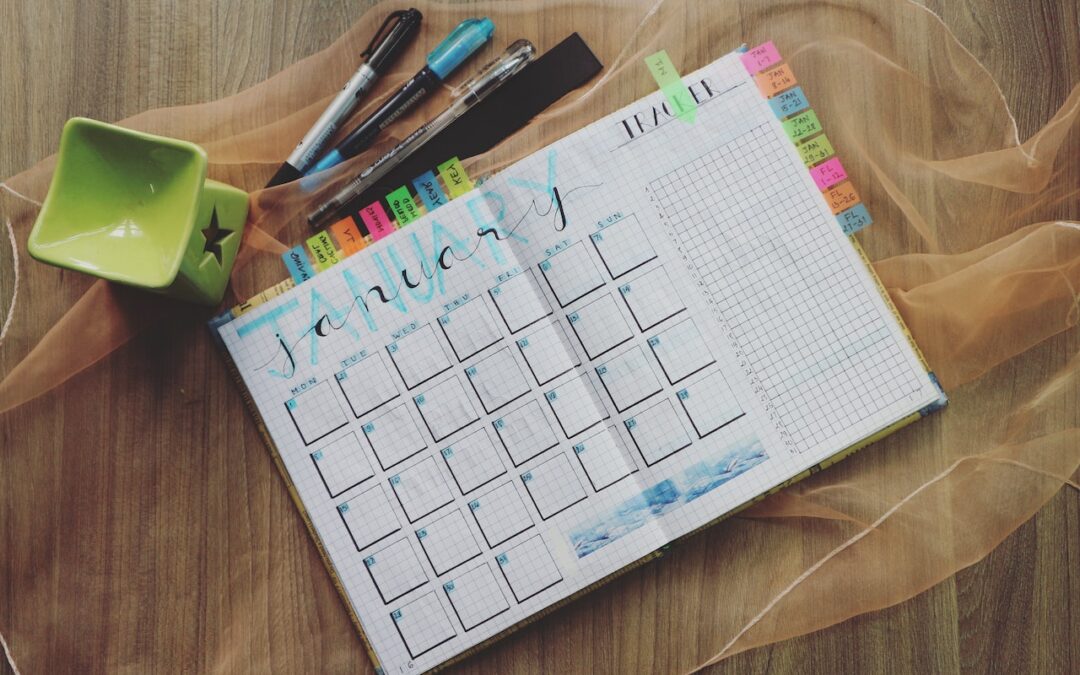In a world where distractions are everywhere and the demands of daily life can easily overwhelm even the most organized of minds, finding an effective system to manage tasks, goals, and thoughts becomes not just a convenience, but a necessity. For individuals with ADHD (Attention Deficit Hyperactivity Disorder), the challenge of maintaining focus and structure is often amplified. However, there exists a powerful tool that can provide assistance in this endeavor – the art of bullet journaling. In this comprehensive exploration, we’ll delve deep into the concept of bullet journaling, its creation and setup, the reasons it is uniquely helpful for individuals with ADHD, and how you can approach it as a dynamic living document that seamlessly combines flexibility and structure to serve as your visual and portable command center.
Understanding Bullet Journaling: A Personalized Approach
 At its core, bullet journaling is an analog system designed to blend various organizational techniques into a single, versatile platform. Developed by Ryder Carroll, whose insights are deeply explored in his influential book “The Bullet Journal Method,” this method encompasses the functionalities of a planner, diary, to-do list, and creative outlet, all within the pages of a customizable notebook. Unlike pre-structured planners, bullet journaling provides individuals the freedom to tailor the system to their unique needs, making it an invaluable resource for those navigating the intricacies of ADHD.
At its core, bullet journaling is an analog system designed to blend various organizational techniques into a single, versatile platform. Developed by Ryder Carroll, whose insights are deeply explored in his influential book “The Bullet Journal Method,” this method encompasses the functionalities of a planner, diary, to-do list, and creative outlet, all within the pages of a customizable notebook. Unlike pre-structured planners, bullet journaling provides individuals the freedom to tailor the system to their unique needs, making it an invaluable resource for those navigating the intricacies of ADHD.
Setting Up Your Bullet Journal: Building Your Foundation
Embarking on your bullet journaling journey requires several foundational steps that set the stage for an effective system:
Choosing a Notebook for Comfort and Practicality
Selecting the right notebook is essential, aiming for one with dotted or grid pages. These layouts strike a perfect balance between structure and creativity, ensuring practicality and comfort for individuals navigating the intricacies of ADHD. Importantly, the focus here is on finding what suits you best, rather than chasing a sense of perfection.
Crafting an Evolving Index for Quick Navigation
To enhance navigation, dedicate the initial pages to an index – a practical tool that grows with your bullet journaling journey. As you progress, number your pages, creating a clear roadmap to swiftly locate content. As you add entries, take a moment to include relevant keywords and topics in the index.
Personalize Your Approach
Here’s a tip from my personal experience that complements the index: Post-It tabs. These versatile tabs serve as markers that you can affix to the edge of pages. Label each tab according to the section it designates – whether it’s ‘Work Projects,’ ‘Inspiration,’ or ‘Daily Logs.’ This method allows you to visually access different sections without flipping through pages or referring back to the index. This approach embraces your individuality, reflecting your style of organization and creating a tactile, interactive element within your journal.
Implementing Visual Symbols for Streamlined Organization
Employing symbols for categorization is a powerful technique. Symbols like a dot (•) for tasks, an open circle (○) for events, and a dash (-) for notes offer a visual shorthand that not only speeds up identification but also injects visual engagement into your journal. As you flip through, these symbols provide instant insight, helping you maintain focus while capturing the essence of each entry. This visual organization harmonizes perfectly with the ADHD-friendly nature of the bullet journal, providing an intuitive way to categorize thoughts in sync with your dynamic thought process. Feel free to create your own visual symbols.
Embracing Monthly and Daily Logs for Rhythm and Reflection
 Curate a rhythm of reflection and planning by starting each month with a general overview. In this section, write down important dates, upcoming goals, and fixed deadlines. This higher-level perspective empowers you to grasp the overarching theme of your month, facilitating better time and energy management. Following this, create daily logs – the pulse of your bullet journal. Here, you’ll document tasks, appointments, and even fleeting thoughts. Consistently engaging with your daily log initiates an ongoing cycle of reflection and flexible planning. As you reflect on the successes and challenges of each day, you foster mindfulness and self-awareness. Simultaneously, projecting forward helps with anticipating tasks and commitments, providing an invaluable structure for individuals managing ADHD. This dual process cultivates a profound connection with your goals and responsibilities, truly transforming your bullet journal into a steadfast companion on your journey to heightened productivity and focus.
Curate a rhythm of reflection and planning by starting each month with a general overview. In this section, write down important dates, upcoming goals, and fixed deadlines. This higher-level perspective empowers you to grasp the overarching theme of your month, facilitating better time and energy management. Following this, create daily logs – the pulse of your bullet journal. Here, you’ll document tasks, appointments, and even fleeting thoughts. Consistently engaging with your daily log initiates an ongoing cycle of reflection and flexible planning. As you reflect on the successes and challenges of each day, you foster mindfulness and self-awareness. Simultaneously, projecting forward helps with anticipating tasks and commitments, providing an invaluable structure for individuals managing ADHD. This dual process cultivates a profound connection with your goals and responsibilities, truly transforming your bullet journal into a steadfast companion on your journey to heightened productivity and focus.
A Customized Tool
Remember that your bullet journal is a tool tailored to you. Personalize these techniques according to your preferences. This flexibility is the hallmark of the bullet journal, a priceless resource for those navigating ADHD – it molds itself to your requirements, empowering you to harness its potential without being ensnared by perfectionism’s constraints.
Bullet Journaling and ADHD: A Synergistic Relationship
 The synergy between bullet journaling and ADHD is rooted in its adaptability and visual appeal. In embracing the four pillars of bullet journaling – visual organization, adaptability, mindfulness, and empowering task management – individuals with ADHD unlock a personalized toolkit for managing their unique cognitive landscape. The bullet journal becomes more than just a notebook; it becomes a canvas on which the vivid colors of focus, growth, and reflection come to life.
The synergy between bullet journaling and ADHD is rooted in its adaptability and visual appeal. In embracing the four pillars of bullet journaling – visual organization, adaptability, mindfulness, and empowering task management – individuals with ADHD unlock a personalized toolkit for managing their unique cognitive landscape. The bullet journal becomes more than just a notebook; it becomes a canvas on which the vivid colors of focus, growth, and reflection come to life.
Visual Organization for Enhanced Focus
Unlocking the Power of Visual Thinking: For individuals with ADHD, the innate ability to excel in visual processing becomes an asset in the world of bullet journaling. This method brilliantly taps into this strength by incorporating colors, layouts, and even sketches. This visual symphony creates an environment where engagement is elevated, propelling ADHD individuals into an optimal state of focus. The interplay of colors and visually distinct elements provides a stimulating backdrop that captivates attention and streamlines information absorption. Each element becomes a visual cue, a strategic ally in the pursuit of an organized mind.
Flexibility to Pivot as Life Shifts
Adaptable to Changes in Life’s Course: In a world characterized by constant change, the flexibility that bullet journaling offers is nothing short of a superpower. Unlike traditional, rigid planners, the bullet journal evolves alongside you. This adaptability means that if a particular layout isn’t proving effective, you’re free to pivot without feeling constrained. Such freedom prevents the stagnation that often derails well-intentioned organizational efforts. It’s a dynamic approach that acknowledges that your life is as fluid as your thoughts, ensuring that your journal becomes a faithful companion on your journey of growth.
Fostering Mindfulness and Reflection
Nurturing Self-Awareness: In the whirlwind of modern life, carving out moments for mindfulness can be a challenge, especially for individuals with ADHD. However, the bullet journal introduces an elegant solution. The practice of consistently engaging with your journal nurtures mindfulness, gently guiding your attention to the present moment. As you capture your thoughts, plans, and reflections, you also capture fleeting ideas that might have otherwise slipped away. This act of recording creates a space for self-awareness to flourish, allowing you to observe your thought patterns, manage impulsivity, and gradually cultivate a deeper connection with your inner self.
Intentional Task Management
From Overwhelm to Control: The feeling of being overwhelmed by an unchecked to-do list is a common challenge for many, and it can be particularly intensified for individuals with ADHD. Here’s where the bullet journal’s ingenious approach to task management comes into play. The practice of migrating tasks from one day to another isn’t just about transferring unfinished business; it’s a strategic method of tackling overwhelm head-on. By evaluating the significance of each task and determining its priority, you regain control over your to-do list. This practice fosters a sense of accomplishment as you check off tasks, each marked migration serving as a small victory on your path to mastering your responsibilities.
Harnessing Your Bullet Journal’s Living Document Potential
Approaching your bullet journal as a living document infuses it with adaptability and structure:
Embrace Fluidity and Evolution
Navigating Life’s Dynamic Nature: In the tapestry of life, change is the only constant. Embracing this truth becomes a powerful asset within the realm of bullet journaling. Recognize that plans are subject to shifts, and the system should evolve in response. Techniques like “rapid logging” epitomize this philosophy. It’s a method of concise note-taking that captures essential information in a snap. This approach resonates particularly well with the fast-paced nature of modern life. Rapid logging becomes your ally, swiftly recording thoughts, events, or tasks without burdening you with lengthy narratives. This adaptability is not just pragmatic; it’s liberating. It empowers you to capture the essence of the moment without being confined by the need for perfection.
Curating Collections and Modules
 Crafting Your Personalized Universe: Your bullet journal is more than a mere organizational tool; it’s a canvas for self-expression. Within its pages, you have the creative license to curate collections and modules that cater to your ever-evolving interests. From mapping out ambitious goals to creating reading lists, meal planning, fitness tracking, helping you maintain relationships or even habit-tracking sections – these collections are an extension of your aspirations and pursuits. As your interests take new forms, your bullet journal adapts in kind. These sections become dynamic spaces that grow with you, capturing your evolution and interests as they unfold. Each collection, each module, represents a chapter in your journey, a testament to your progress and potential.
Crafting Your Personalized Universe: Your bullet journal is more than a mere organizational tool; it’s a canvas for self-expression. Within its pages, you have the creative license to curate collections and modules that cater to your ever-evolving interests. From mapping out ambitious goals to creating reading lists, meal planning, fitness tracking, helping you maintain relationships or even habit-tracking sections – these collections are an extension of your aspirations and pursuits. As your interests take new forms, your bullet journal adapts in kind. These sections become dynamic spaces that grow with you, capturing your evolution and interests as they unfold. Each collection, each module, represents a chapter in your journey, a testament to your progress and potential.
Regular Review for Continuous Evolution
The Power of Reflection: Regular reflection is a cornerstone of personal growth, and your bullet journal provides a structured space for this transformative practice. Allocating dedicated time for periodic reviews – whether at the end of a month or week – allows you to gather insights from your accomplishments and challenges. This process is far from mechanical; it’s a bridge to continuous improvement. By observing patterns, recognizing achievements, and learning from setbacks, you pave the way for intentional growth. These reviews aren’t just retrospectives; they’re blueprints for the future. As you adjust your strategies based on these insights, you embody the essence of adaptability, ensuring that your journey is one of upward momentum.
Visual Aids for Immediate Clarity
Instant Decision-Making with Visual Cues: In a fast-paced world, clarity is invaluable. Visual aids serve as immediate guides, enabling quick decisions and minimizing cognitive load. Sticky notes, tabs, and color-coded sections are your allies here. A glance at a color-coded section instantly directs your attention to the information you seek. A tab fluttering from the edge serves as a friendly marker, guiding you straight to your designated section. These visual cues, unobtrusive yet highly effective, streamline your interaction with your journal. They’re the navigational stars that illuminate your path, making the experience of engaging with your bullet journal intuitive and rewarding.
Conclusion: Your ADHD Ally and Productivity Partner
 Bullet journaling holds immense potential for individuals navigating the complexities of ADHD. As a malleable, personalized, and visually engaging system, it serves as a portable command center for thoughts, tasks, and aspirations. By embracing its role as a living document, you empower it to evolve, providing the necessary structure for managing ADHD while accommodating life’s uncertainties. Whether you’re an artistic thinker or a pragmatic planner, the bullet journal becomes your steadfast ally in conquering ADHD and thriving in a world abundant with distractions. In the realm of organization and focus, the bullet journal stands as both an artful creation and an indispensable tool. With its help, you’re not just managing tasks – you’re mastering your path toward enhanced productivity, self-awareness, and a more fulfilling life.
Bullet journaling holds immense potential for individuals navigating the complexities of ADHD. As a malleable, personalized, and visually engaging system, it serves as a portable command center for thoughts, tasks, and aspirations. By embracing its role as a living document, you empower it to evolve, providing the necessary structure for managing ADHD while accommodating life’s uncertainties. Whether you’re an artistic thinker or a pragmatic planner, the bullet journal becomes your steadfast ally in conquering ADHD and thriving in a world abundant with distractions. In the realm of organization and focus, the bullet journal stands as both an artful creation and an indispensable tool. With its help, you’re not just managing tasks – you’re mastering your path toward enhanced productivity, self-awareness, and a more fulfilling life.
Begin Online Coaching for Executive Functioning / ADHD
Ready to gain control and enhance your executive functioning? As an experienced and compassionate coach, I specialize in providing support for executive functioning and ADHD. To embark on your journey, please reach out to me at 708-264-2899 or email hello@suzycarbrey.com to schedule a FREE 20-minute discovery call consultation.
With a background as a speech-language pathologist, I have a strong foundation in executive functioning coaching. My graduate degree program in SLP placed a significant emphasis on cognition, including executive functions, and I have years of experience in medical rehabilitation, providing cognitive-communication therapy. Additionally, I have completed an ADHD Services Provider certification program, I am Solutions-Focused Brief Therapy Diamond Level 1 certified and I am trained in the Seeing My Time® executive functioning curriculum.
Experience the convenience and effectiveness of online coaching, backed by studies that demonstrate equal results to in-person services. Parents, professionals, and emerging adults love the convenience and privacy of receiving coaching from their own homes.
Whether you reside in Chicago, Milwaukee, Indianapolis, Kansas City, or anywhere else around the globe, I am here to assist you. Schedule your discovery call consultation today, and I eagerly anticipate the opportunity to work with you!
Please note that although I am a certified speech-language pathologist, all services Suzy Carbrey LLC provides are strictly coaching and do not involve clinical evaluation or treatment services. If you require a formal speech therapy evaluation and treatment, please inform me, and I can provide appropriate recommendations.

